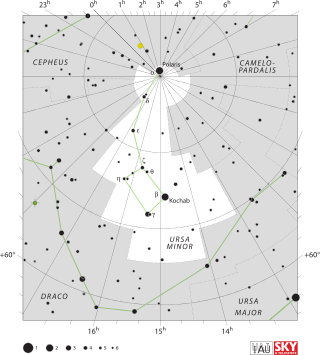
Epsilon Ursae Minoris is a binary star system in the northern circumpolar constellation of Ursa Minor. It is visible to the naked eye with a combined apparent visual magnitude of 4.19. Based upon an annual parallax shift of 10.73 mas as seen from the Earth, it is located around 300 light years from the Sun. The pair are drawing nearer to the Sun with a radial velocity of −10.57 km/s.

9 Andromedae, abbreviated 9 And by convention, is a variable binary star system in the northern constellation Andromeda. 9 Andromedae is the Flamsteed designation, while it bears the variable star designation AN Andromedae, or AN And. The maximum apparent visual magnitude of the system is 5.98, which places it near the lower limit of visibility to the human eye. Based upon an annual parallax shift of 7.1 mas, it is located 460 light years from the Earth.

44 Boötis or i Boötis is a triple star system in the constellation Boötes. It is approximately 41.6 light years from Earth.

31 Camelopardalis is a binary star system in the northern circumpolar constellation of Camelopardalis. It is visible to the naked eye as a dim point of light with a peak apparent visual magnitude of +5.12. Parallax measurements provide a distance estimate of approximately 460 light years away from the Sun, and the system is drifting closer to the Earth with a radial velocity of −3 km/s.
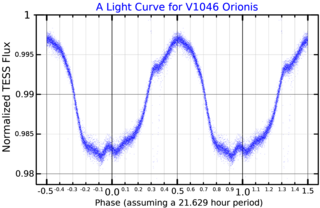
HD 37017 is a binary star system in the equatorial constellation of Orion. It has the variable star designation V1046 Orionis; HD 37017 is the identifier from the Henry Draper Catalogue. The system is a challenge to view with the naked eye, being close to the lower limit of visibility with a combined apparent visual magnitude of 6.55. It is located at a distance of approximately 1,230 light years based on parallax, and is drifting further away with a radial velocity of +32 km/s. The system is part of star cluster NGC 1981.

DV Aquarii is a binary star system in the zodiac constellation of Aquarius. It has a peak apparent visual magnitude of 5.89, which is bright enough to be visible to the naked eye. The distance can be estimated from its annual parallax shift of 11.2 mas, yielding a separation of 291 light years.

EO Aurigae is an eclipsing binary of Algol type in the northern constellation of Auriga. With a combined apparent magnitude of 7.71, it is too faint to be seen with the unaided eye.

YZ Cassiopeiae is a star system 103.8 parsecs (339 ly) away from Earth, in the constellation Cassiopeia. It comprises three stars: an eclipsing Algol-type binary and a visually fainter star about 3000 AU distant.

LS Canis Majoris is an eclipsing binary star located around 1,510 light years from Earth in the constellation Canis Major. Its apparent magnitude ranges from 5.63 to 5.79. The orbital period of binary pair and the period of light variation is 70.048 days.
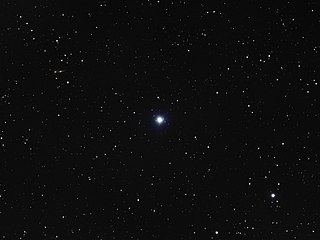
2 Lyncis is a binary star system in the northern constellation Lynx. It is visible to the naked eye, having an apparent visual magnitude of 4.44. The distance to this system, judging by an annual parallax shift of 20.83±0.40 mas, is around 157 light years. It is moving closer to the Sun with a heliocentric radial velocity of −2 km/s.

QZ Puppis is a class B2.5V star in the constellation Puppis. Its apparent magnitude is 4.5 and it is approximately 650 light years away based on parallax.
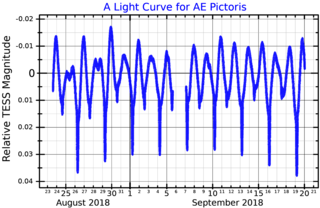
AE Pictoris is an eclipsing binary star system in the southern constellation of Pictor. This dim, blue-white hued point of light is just barely visible to the naked eye; it has an apparent visual magnitude of 6.09, which drops to magnitude 6.14 during an eclipse. The system is located around 1,430 light years away from the Sun based on parallax, and it is receding with a radial velocity of 34 km/s.
λ Librae is the Bayer designation for a binary star system in the zodiac constellation of Libra. It can be faintly seen with the naked eye, having an apparent visual magnitude of 5.03. With an annual parallax shift of 10.54 mas, it is roughly 310 light years from the Sun. At that distance, the visual magnitude of this system is diminished by an extinction factor of 0.22 due to interstellar dust. It is 0.1 degree north of the ecliptic.
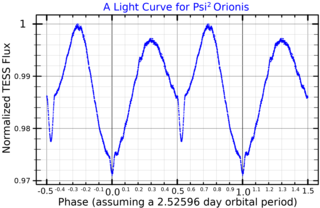
Psi2 Orionis a binary star system in the equatorial constellation of Orion. It has an apparent visual magnitude of 4.6, indicating that it is visible to the naked eye. Based upon an annual parallax shift of 2.87 mass, it is roughly 1,100 light years distant from the Sun.
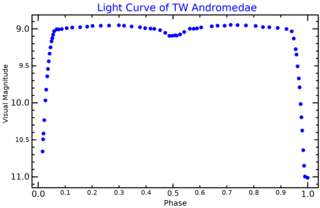
TW Andromedae is an eclipsing binary star, classified also as an Algol variable star, in the constellation Andromeda. Its brightness varies with a period of 4.12 days, and has a typical brightness of magnitude 8.98 but decreasing down to a magnitude of 11.04 during the main eclipse.

AO Serpentis is an eclipsing binary star system in the Serpens Caput segment of the Serpens constellation. It is invisible to the naked eye with a typical apparent visual magnitude of 11.04. Variable star observers record a peak magnitude of 10.7, dropping to 12.0 during the primary eclipse and 10.8 from the secondary eclipse. The distance to this system is approximately 1,450 light years based on parallax measurements.

AG Virginis is an eclipsing binary star system in the equatorial constellation of Virgo. With a maximum apparent visual magnitude of 8.51 it is too faint to be visible to the naked eye. The system is located at a distance of approximately 820 light years from the Sun based on parallax measurements.

BH Virginis is a binary star system in the equatorial constellation of Virgo. With a typical apparent visual magnitude of 9.6, it is too faint to be visible to the naked eye. Based on parallax measurements, it is located at a distance of approximately 488 light years from the Sun. The system is drifting closer with a net radial velocity of −23 km/s.

AH Virginis is a contact binary star system in the equatorial constellation of Virgo, abbreviated AH Vir. It is a variable star with a brightness that peaks at an apparent visual magnitude of 9.18, making it too faint to be viewed with the naked eye. The distance to this system is approximately 338 light years based on parallax measurements, and it is drifting further away with a mean radial velocity of 7 km/s. O. J. Eggen in 1969 included this system as a probable member of the Wolf 630 group of co-moving stars.

SU Cygni is a triple star system in the northern constellation of Cygnus, abbreviated SU Cyg. The primary component of the system is a classical Cepheid variable with a period of 3.8455473 days. The changing luminosity of this star causes the system to vary in brightness from a peak apparent visual magnitude of 6.44 down to magnitude 7.22 over the course of its cycle. The distance to this system is approximately 3,200 light years based on parallax measurements. It is a member of the Turner 9 open cluster of stars.



















